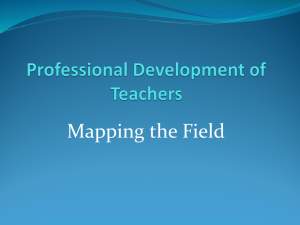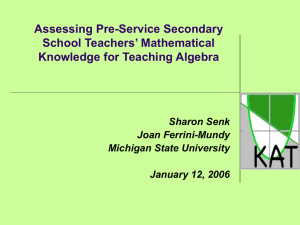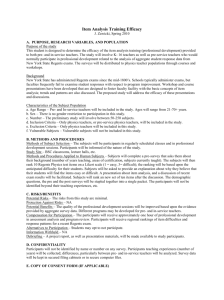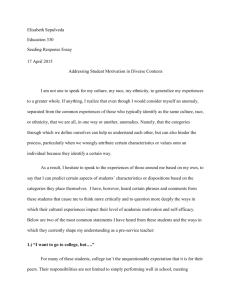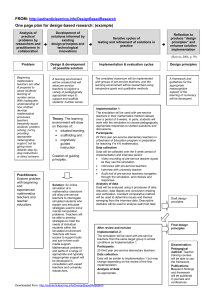CONNECTING MATH AND SCIENCE
advertisement
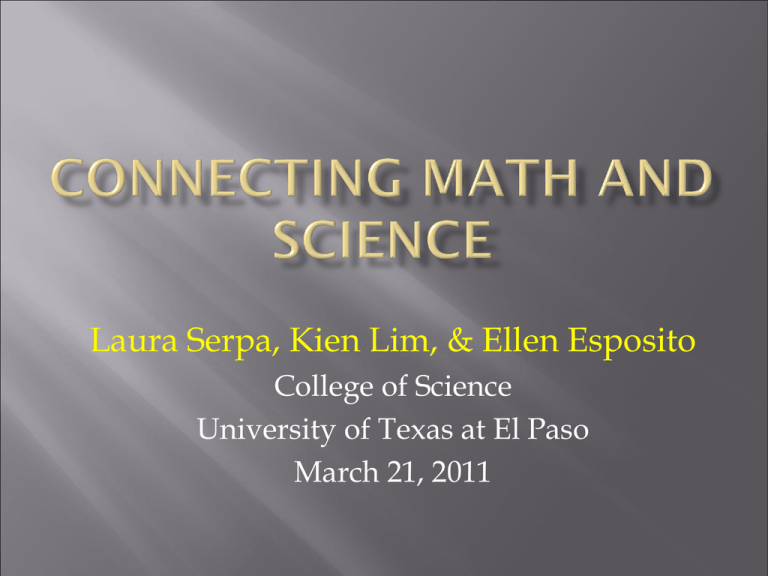
Laura Serpa, Kien Lim, & Ellen Esposito College of Science University of Texas at El Paso March 21, 2011 Mathematics is the language of science Science inspires mathematics Students see mathematics and science as independent subjects Both mathematics and science appear to stimulate some “higher level” thinking 2008-2009 22 Pre-service teachers 26 In-service teachers (5+ years) 8 Novice teachers (0-4 years) 3 Pre-service MAT 2009-2010 17 Pre-service teachers 27 In-service teachers (2+ years) 8 Novice teachers (0-1 year) 1 Pre-service MAT 2010-2011 8 Pre-service teachers 19 In-service teachers (2+ years) 1 Novice teachers (0-1 year) 0 Pre-service MAT So… How do we achieve our goals and create good teachers in a program that addresses a large number of participants from very different backgrounds? • • • Problem-based lessons Inquiry Lesson planning 2010-11 Focus on writing curriculum: First semester devoted entirely to 2 major activities that integrate mathematics and science and could form the basis for multiple lessons. • Additional material was presented on exploring knowledge or how to ask question • Egg-Buoyancy Experiment Density, Buoyancy, Measurement, Ratio Blueness Quotient Problems Concentration, Ratio, Weighted Average Why Density? Density is a fundamental property of matter that often explains why things work the way they do in science Density often controls whether things go up or down Why Ratio? A critical concept for understanding measures of intensive quantities (e.g. speed, flow rate, pressure) Foundational for understanding proportion Why Connect Density and Ratio? Density makes ratio less abstract Ratio highlights the “ratio as a measure” aspect of density which can be generalized to other measures This was the first activity for the new group of participants Participants were given a description of the activity: They would be given a balance; a peeled, hard-boiled egg; and a graduated cylinder containing 500 ml of water. Working in small groups they must find the exact amount of salt that must be added to the water to make the egg float near the center of the graduated cylinder (i.e. achieve neutral buoyancy). They could form their own groups but they must have no more than 6 people in a group. Participants self-selected groups A science in-service teacher group A math in-service teacher group A mixed in-service teacher group Two undergraduate groups • The science group used trial and error. • The math group attempted to find an equation to solve the problem . • The mixed group could not measure the density of the egg accurately enough to proceed with the rest of the assignment. They became frustrated. • The two undergraduate group also used trial and error. They were waiting for someone to give them the correct answer. The initial buoyancy experiment was followed by several problem-sessions about density and buoyancy Our favorite source was: WGBH’s Voyage of doom http://www.pbs.org/wgbh/nova/lasalle/buoyancy.html 1. Comparing Blueness of Two Solutions 3 beakers of blue dye + 2 beakers of water 60 beakers of blue dye + 40 beakers of water Which solution is bluer? Part-part comparison vs. Part-whole comparison 3 60 3 60 2 40 3 2 60 40 3:2 60% Multiplicative comparison vs. A mesaure of blueness Connection to Egg-buoyancy Experiment: Density (concentration of particles): mass/volume Blueness (concentration of dye): bluedye_vol/total_vol 2. Mixing Two Solutions Mix 5L of 40% solution with 10L of 85% solution 40% of 5L 0.0 85% of 10L 0.5 1.0 2. Mixing Two Solutions Mix 5L of 40% solution with 10L of 85% solution Multiple approaches i. Using definition (i.e. separating blue dye and water) 40% 5 85% 10 BQ of Mixture 5 10 ii. Adding BQs or Averaging BQs 40% 85% BQ 40% 85% or, maybe 2 1(40%) 2(85%) ii. Using weighted average BQ 1 2 Making connection: The volumes of the solutions constitute the weights BQ 5(40%) 10(85%) 5 10 in the weighted average method 3. You have 3000mL of Mixture R (BQ of 60%). How much of Mixture R should you add to increase a 200mL solution from BQ of 40% to 55%? Solution Mixture R i. An incorrect approach 200mL 3000mL BQ = 40% 3000(60%) 200(40%) BQ = 60% 55% 3000 200 ii. Guess and check approach iii. Algebraic approach x(60%) 200(40%) 55% x 200 Connection to Egg-buoyancy Expt. Density of salted solution = Density of Egg M salt M water x 500 1.06 1.06 x Vsalt Vwater 2.165 500 How Dense Can You Be?! Integrating Math and Science Using the Human Body Adolfo Payan, Alfonso Vasquez, Veronica Jimenez, Alma Alvarez Integrating Math & Science with a focus on ELL strategies Nancy Aguirre , Bernle Licon , Becky Calderon, Salina Ohman How to Teach for Conceptual Understanding Maria Davis, Roberto Morales, Alexandra Navarro, Gabriel Rocha Sarah Escandon, Joann Estrada, Robert Garcia Integrating Math & Science using Interactive Notebooks and Foldables with Resources from Dinah Zikes Austin Campbell, Evangelina Martinez, Danielle Pena, Hevila Ramos THANK YOU
